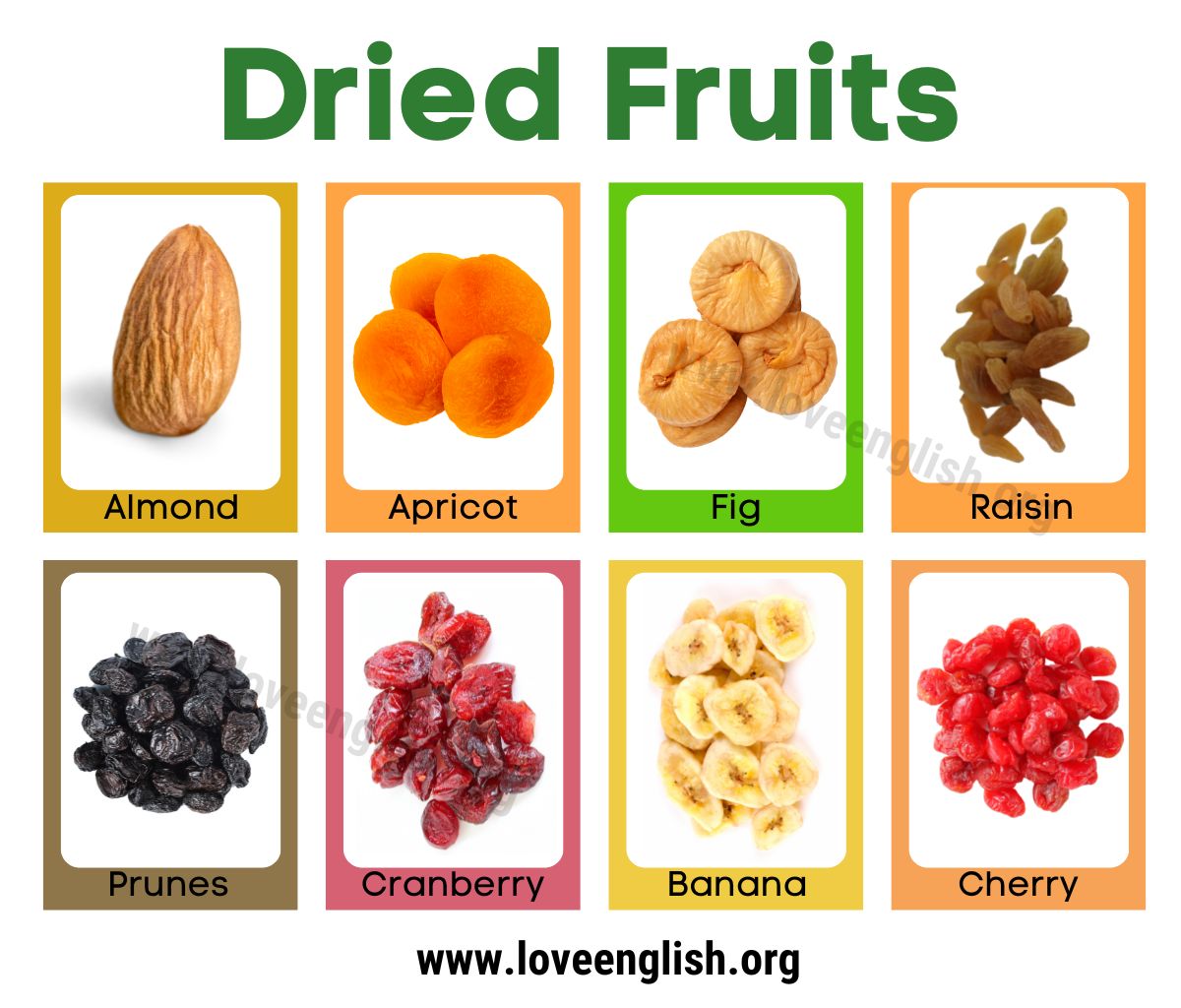Dried fruits are the perfect snack for those looking for a healthy alternative to sweets and processed snacks. They are packed full of fiber, vitamins, and minerals, which makes them counterintuitively sweet and delicious. Eating dried fruit can help you increase your intake of many vitamins and minerals, as well as help with weight loss. In addition to being an excellent source of nutrition, there are a variety of terms associated with this tasty snack.
List of Dried Fruit Names
- Almond
- Apricot
- Fig
- Pistachio
- Raisin
- Prune
- Plum
- Apple
- Cranberry
- Mango
- Pear
- Banana
- Cherry
- Blueberry
- Strawberry
- Peach
- Papaya
- Kiwi
- Persimmon
- Raspberry
- Pineapple
- Grapes
- Orange
- Melon
- Goji berry
Dried Fruits with Facts
Raisins: These small, sweet fruits are made from drying grapes. They’re often used in baking and cooking recipes due to their sweetness but they also make an excellent snack on their own or are added to yogurt or cereal.
Apples: Apples are one of the most popular dried fruits available in stores. After they have been dried they become much sweeter than when fresh. They make a great addition to snacks or salads.
Cranberries: Cranberries contain compounds that may help promote healthier hearts and ward off urinary tract infections when eaten regularly in either fresh or dried form.
Figs: Figs are small in size but big in flavor! They offer a slightly nutty taste and texture that will bring any dish up a notch! Plus they offer high amounts of dietary fiber, calcium, and magnesium essential nutrients necessary for proper digestion ad cell formation respectively.
Mangos: Sweet mangos make a great addition to any meal but even more so after being dehydrated and preserved! Mangos contain large amounts of Vitamin C making them an excellent choice for boosting your immune system in addition to providing energy!
Pears: Pears are light yet flavorful when dried making them an excellent choice for snacking on while keeping calories down at the same time! Pears also contain potassium which helps regulate fluid balance in our bodies as well as being beneficial for maintaining healthy skin health too!
Dried Fruit List
Common Dried Fruits
- Raisins
- Apricots
- Dates
- Prunes
- Figs
- Cranberries
- Mangoes
- Apples
- Bananas
- Cherries
- Blueberries
- Strawberries
- Peaches
- Pears
- Papayas
- Kiwis
- Persimmons
- Plums
- Goji berries
Healthiest Dried Fruits
- Goji berries
- Prunes
- Apricots
- Figs
- Dates
- Cranberries
- Raisins
Freeze Dried Fruits
- Strawberries
- Blueberries
- Raspberries
- Blackberries
- Pineapple
- Mangoes
- Apples
- Bananas
- Grapes
- Peaches
- Pears
- Kiwi
- Oranges
- Cranberries
- Melons
Dried Fruit Benefits
- Dehydrated – This refers to the process of removing moisture from the fruit in order to preserve it. Dehydrating helps stop spoilage and prevent bacteria growth.
- Selection – When selecting dried fruits, look for varieties that are plump and moist. Avoid products that contain added fat or sugar, which can detract from its nutritional value.
- Preservatives – Some brands may use preservatives such as sulfur dioxide or potassium sorbate to extend the shelf life of their products. Check labels for additives before purchasing dried fruit.
- Sulfur – Sulfur-based products help retain color and prevent oxidation during storage, but they can also add an unpleasant taste to foods. If you’re sensitive to sulfites, opt for unsulfured products instead.
- Sun-dried – Sun-dried fruits retain more nutrients than other varieties because the dehydration process does not involve artificial heat or chemicals as other commercially available dehydrated fruits do.
- Organic – Organic means that no pesticides were used in the production and processing of the product, so these will be higher quality than non-organic options when it comes to nutrition and flavor profile.
- Lyophilized – Lyophilized (aka freeze-dried) fruits are flash frozen at temperatures below freezing while subjected to reduced pressure conditions which removes moisture content while preserving flavor and nutrient content intact.
Frequently Asked Questions
What Is Dried Fruit?
Dried fruit is a type of food prepared by evaporating all the water content from fresh fruits. The resulting product retains the nutritional benefits of fresh fruit while prolonging its shelf life. As a result, dried fruit is a convenient snack that can be eaten on the go and stored without needing refrigeration.
What Is Freeze-Dried Fruit?
Freeze-dried fruit is a dried, shelf-stable product made by removing most of the water content from freshly harvested fruits. The process begins by quick-freezing the fresh fruit in subzero temperatures, then subjecting it to a vacuum chamber to remove nearly all the moisture content. What remains is a light, crunchy snack with an intense sweetness and flavor profile due to its concentrated natural sugars. Typical freeze-dried fruits include apples, bananas, mangos, pears, and strawberries.
What Is the Most Common Dried Fruit?
The most common types of dried fruit are raisins, apricots, prunes, dates, figs, apples, and cranberries. Raisins are dried grapes that are naturally sweet and have a chewy texture. Apricots, dates, and prunes have been preserved through a dehydration process or sugaring technique that requires heating or adding sugar to the fruit. Figs are often sun-dried or dried in an oven before consumption. Apples can be dehydrated and turn into apple chips. Cranberries may be dried whole or chopped up and added to cereal or trail mix for extra flavor. Dried fruits are typically high in dietary fiber and contain essential vitamins and minerals such as Vitamin A, B-complex vitamins, calcium, magnesium, and potassium.
Related Links
- All fruit names
- Tropical fruits
- Citrus fruits
- Aggregate fruits
- Exotic fruits
- Yellow fruits
- Green fruits
Last Updated on March 20, 2023





